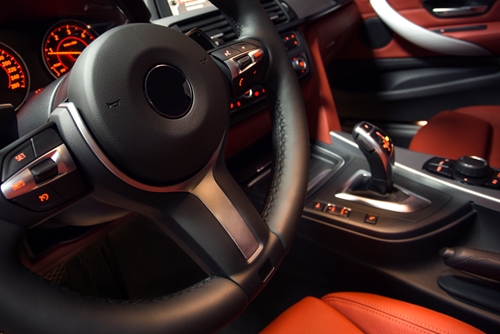Get the Inside Scoop on Preserving Automotive Interiors with Protective Films

Here on the ABI Tape blog, we’ve talked a lot recently about the importance of protecting manufactured cars during assembly, as well as presale logistics. But while our attention has traditionally veered toward exteriors, preserving automobile interiors matter just as much, if not more so.
Whereas outer panels were designed to withstand the elements – especially if they’re guarded by AutoWrap protective films – interiors are often more vulnerable to heavy wear. Manufacturers should let the end user break in these components on their own and not beat them up before buyers drive off the lot. What interior automotive features should OEMs insulate from damage with help from protective masking?
“Carpet masks must adequately resist pressure and punctures during assembly.”
Carpet and trim
As assembly workers put the finishing touches on freshly manufactured vehicles, they’ll no doubt tread on the carpet and come in contact with interior trim. Each footstep or interaction could carry grit or other contaminants into the car and irreparably ruin its perfect condition. Protective tapes shield these sensitive features.
However, not any surface protection product will do. If carpet masks are to take the brunt of every footfall, they must adequately resist pressure and punctures during assembly. Holes compromise the integrity of the interior and “floating” protective films that do not cling tightly are a tripping hazard to assembly workers and prospective buyers hopping in and out of vehicles. Furthermore, protective films should not leave behind residue or pull fabric from the carpet upon removal. ProtectRite offers tear-free protection for carpets and trim along doors and kick panels that stays where it’s applied and lasts all the way to point of sale.
High-use components
Car door interiors receive a fair amount of use – we’d go so far as to say “abuse” – during presale. How else are assembly workers or shipping professionals expected to access the inside of a vehicle? That said, every interaction increases the chances of damage occurring to the interior, especially in areas of the car with heavy traffic, like driver and passenger seats.
“ProtectRite works with smooth, matte and textured surfaces.
By protecting respective door components with protective films, manufacturers not only prevent errant thumbprints or stains from jeopardizing sales or product prices, they also subconsciously guide users where to touch to preserve an immaculate surface. Protective films are particularly useful when covering wooden, metallic or other finishes where grease or scratches would stand out to buyers. ProtectRite in particular works with smooth, matte, textured or highly textured surfaces.
Dashboard instrument panels
Speaking of which, if customers travel out to the dealership, chances are they’ll test drive a model they’re interested in. According to a recent survey from DMEautomotive, 84 percent of car buyers take vehicles out for a spin before committing to a purchase. Manufacturers that invest in protective films for dashboard surfaces and instrument panels, therefore, prepare their vehicles with the potential for test driving in mind. If they want buyers to be wowed by the clean, blemish-free interior, carmakers must concede a few buyers might get behind the wheel before a car gets sold and act on that information.
That said, if you were to read further into the test driving trend, you’d realize it’s dropping. More shoppers take to the internet to do the majority of their car shopping – in fact, 1 in 6 never test drive a vehicle at all. What does that tell carmakers? Customers who do venture to lots to test drive mean serious business and expect excellent customer service and a truly flawless product. Give them both by applying protective films to interior car components. These tape products show how much manufacturers and dealerships value their customers and their products.


